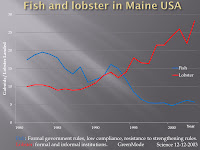 People in many situations collaborate, for example companies setting carbon neutral targets for themselves.
People in many situations collaborate, for example companies setting carbon neutral targets for themselves.
But does this see the long term protection of resources? Resources that can be overused by individuals and groups resulting in much less for everyone? Like the world’s ability to absorb carbon?
The graph illustrates a great example of this in today’s world. It shows how voluntary group effort – from lobster fishing communities – has succeeded where government regulation did not.
The blue line is the catch for a degraded inshore fishery. This is in Maine, USA and the fishery is governed by legislated quotas, catch limits and, licensing etc. These rules are not credible with relatively low compliance and strong resistance to strengthening restrictions. And the fish catch, everyone’s livelihood, suffers.
Red is the Maine lobster fishery. Its governed by formal and informal groups strongly influencing state rules. The result – a lot more lobster.
The challenge is to apply this knowledge to all situations including climate change. As a signal of its importance, the joint winner of the 2009 economics Nobel Prize was Elinor Ostrom. Elinor leads much of this work. In the words of the Nobel committee she has challenged the conventional wisdom that common property is poorly managed and should be either regulated by central authorities or privatized. … user-managed fish stocks, pastures, woods, lakes, and groundwater basins.. often see good outcomes
That is we do protect resources, voluntarily and willingly.
Graph data: Science 12-12-2003 The Struggle to Govern the Commons Thomas Dietz, Elinor Ostrom, and Paul C. Stern
